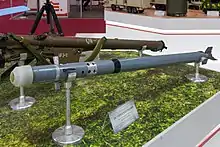.jpg.webp)
Members of the Indonesian Quick Reaction Forces Command (Kopasgat) inspecting a QW-3 MANPADS launcher
The QW-series (pinyin: Qian Wei)[1] are man-portable air-defense systems (MANPADS) developed by the People's Republic of China.[2]
QW-1
| QW-1 | |
|---|---|
| Type | Man-portable air-defense system |
| Place of origin | |
| Specifications | |
| Mass | 36 pounds (16 kg)[3] |
Operational range | 5 kilometres (3.1 mi) (maximum)[4] |
| Flight ceiling | 2.5 miles (4.0 km)[3] |
Guidance system | Infrared homing[4] |
Launch platform | MANPADS |
The QW-1 (NATO reporting name: CH-SA-7)[5] is the initial version. It is likely a copy or derivative of the Soviet 9K38 Igla-1 MANPAD.[2]
The system was unveiled in 1994.[6]
Variants
- QW-1M
- Modernized version. Also used by Kata'ib Hezbollah.[7]
- Anza-2
- Version developed or produced in Pakistan.[4]
- Misagh-1
- Version developed or produced in Iran.[4] Also used by Iraqi insurgents[6] and Kata'ib Hezbollah.[7]
- Misagh-2
- Version developed or produced in Iran.[4] According to some sources, the Misagh-2 may be a copy of the QW-1M.
QW-2
| QW-2 | |
|---|---|
 QW-12 | |
| Type | Man-portable air-defense system |
| Place of origin | |
| Service history | |
| Used by | |
| Production history | |
| Produced | After 1998[9] |
| Specifications | |
| Length | 1.59 metres (5.2 ft)[1] |
Operational range | 0.5–6 kilometres (0.31–3.73 mi)[1] |
| Flight ceiling | 0.01–4 kilometres (0.0062–2.4855 mi)[1] |
Guidance system | Infrared homing[4] |
Launch platform | MANPADS Ground vehicles[10] |
The QW-2 (NATO reporting name: CH-SA-8)[5] has improved performance against targets flying faster and at lower-altitude than the QW-1.[10]
Variants
- QW-12
- Uses a laser proximity detonator. Unveiled in November 2014.[11]
QW-3
The QW-3 uses semi-active homing.[12]
See also
- Anza (missile)
- The FN-6 and HN-5 are other Chinese man-portable surface-to-air missiles.
- FIM-92 Stinger
- Qaem
- Misagh-2
- Grom (missile)
- Mistral (missile)
References
- 1 2 3 4 5 Dominguez, Gabriel (15 January 2018). "Footage suggests QW-2 MANPADS has entered service with Turkmenistan Army". Janes. Archived from the original on 17 January 2018. Retrieved 6 March 2022.
- 1 2 Chinese Tactics (2021): page C-3
- 1 2 Whitmire, James C. (December 2006). Shoulder Launched Missiles (a.k.a. MANPADS): The Ominous Threat to Commercial Aviation (PDF) (Report). The Counterproliferation Papers. Vol. 37. Maxwell Air Force Base, Alabama: United States Air Force Air University. Retrieved 6 March 2022.
- 1 2 3 4 5 6 SIPRI Yearbook 2007: Armaments, Disarmament, and International Security. Oxford University Press. 2007. p. 684. ISBN 9780199230211.
- 1 2 "6 Asia". The Military Balance 2023. London: Routledge. 15 February 2023.
{{cite book}}:|work=ignored (help) - 1 2 Small Arms Survey (2012). "Surveying the Battlefield: Illicit Arms In Afghanistan, Iraq, and Somalia". Small Arms Survey 2012: Moving Targets. Cambridge University Press. p. 327. ISBN 978-0-521-19714-4. Archived from the original (PDF) on 2018-08-31. Retrieved 30 August 2018.
- 1 2 Iraq: Turning a blind eye: The arming of the Popular Mobilization Units (PDF) (Report). Amnesty International. 5 January 2017. p. 26. MDE 14/5386/2017.
- ↑ Michael Ashkenazi; Princess Mawuena Amuzu; Jan Grebe; Christof Kögler; Marc Kösling (February 2013). MANPADS - A Terrorist Threat to Civilian Aviation? (PDF) (Report). BICC brief. Vol. 47. Bonn International Center for Conversion. p. 159. ISSN 0947-7322. Retrieved 8 September 2019.
- ↑ DeClerq, David (October 1999). Trends in Small Arms and Light Weapons Development: Non-Proliferation and Arms Control Dimensions (PDF) (Report). Department of Foreign Affairs and International Trade, Canada. p. 29. Retrieved 6 March 2022.
- 1 2 Chinese Tactics (2021): page C-2
- ↑ Shukla, Parth; Udoshi, Rahul (16 February 2022). "China tests QW-12 missile capabilities". Janes. Retrieved 6 March 2022.
- ↑ Zeigler, Sean M.; Hou, Alexander C.; Martini, Jeffrey; Norton, Daniel M.; Phillips, Brian; Schwille, Michael; Strong, Aaron; Vest, Nathan (2019). Acquisition and Use of MANPADS Against Commercial Aviation: Risks, Proliferation, Mitigation, and Cost of an Attack (PDF). Santa Monica, California: RAND Corporation. p. 3. ISBN 978-1-9774-0418-3. RR-4304-DOS.
Bibliography
- Chinese Tactics (PDF). Washington, D.C.: United States Department of the Army. 9 August 2021. ATP 7-100.3.
This article is issued from Wikipedia. The text is licensed under Creative Commons - Attribution - Sharealike. Additional terms may apply for the media files.